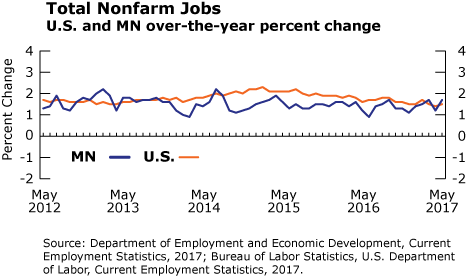by Nick Dobbins
June 2017
Monthly analysis is based on unadjusted employment data.
Employment in the Minneapolis-St. Paul-Bloomington MSA increased by 23,106 (1.2 percent) in May. This lagged slightly behind the statewide growth rate of 1.3 percent for the month. The Twin Cities’ growth was bolstered by increases in a wide range of industry groups. Notable warm-weather industries led the way, with Mining, Logging, and Construction adding 6,647 jobs (8.7 percent) and Leisure and Hospitality adding 8,976 (5.1 percent). This trend was repeated across the state, as every geographic region centered in Minnesota saw gains of greater than 3 percent in both supersectors. (Neither MSA we share with North Dakota, Fargo or Grand Forks, reached that mark in Leisure and Hospitality.) Educational and Health Services lost 1,849 jobs (0.5 percent) on the month, possibly getting a head start on the seasonal losses we generally see in June. On an annual basis the metro area added 38,465 jobs (2 percent). Leisure and Hospitality was the only supersector to contract on the year, losing 1,405 jobs (0.8 percent). The supersector has shown over-the-year declines in every month since October. Losses have come entirely from the larger Accommodation and Food Services component as Arts, Entertainment, and Recreation has shown annual growth in every month since October of 2014.
The Duluth-Superior MSA added 2,414 jobs (1.8 percent) in May, outpacing statewide growth for the month. Over half of the growth came from the usual seasonal suspects, Mining, Logging, and Construction (up 509 or 5.7 percent) and Leisure and Hospitality (up 999, 7.6 percent). Trade, Transportation, and Utilities also added 538 jobs (2.2 percent), most of which was concentrated in Retail Trade (up 471, 3.1 percent), although that growth is likely at least in part a correction to April when the sector shrank by 2.8 percent. Annually Duluth added 1,535 jobs (1.1 percent). This marked the first time since July of 2015 that the MSA had over-the-year growth of 1 percent or greater. Mining, Logging, and Construction continued to lead the way in both actual and proportional gains, adding 724 jobs (8.3 percent), as prospects for mining employment in the area improve. On the flip side, Leisure and Hospitality in the area continues to shed jobs, off by 446 (3.1 percent) over the year, although this is down from the 5.5 percent over-the-year decline the supersector showed in April.
Employment in the Rochester MSA was up by 1,249 (1 percent) in May. Mining, Logging, and Construction added 476 jobs (11.5 percent), the highest numerical and proportional growth of any supersector. It was also the fastest over-the-month growth in that supersector for any MSA in the state in a month when all six MSAs that publish data at that level saw significant growth. Manufacturing lost 120 jobs (1.1 percent) on the month. Annually Rochester added 1,343 jobs (1.1 percent). Educational and Health Services continued to lead the growth, adding 1,428 jobs (3 percent). Over-the-year growth in the supersector has exceeded 2 percent in every month since June of 2015, although this is similar to the statewide growth trend. The steepest annual declines in the MSA came from Leisure and Hospitality, which lost 321 jobs (2.9 percent).
Employment in the St. Cloud MSA was up by 1,179 (1.1 percent) in May. Only two supersectors shed jobs for the month. Government employers lost 211 jobs (1.3 percent), and Educational and Health Services lost 75 (0.3 percent). Annually St. Cloud added 2,255 jobs (2.1 percent). This represents a notable change from the recent trend, which had over-the-year growth in the MSA hovering between 1.1 and 1.5 percent in every month since December. Growth was once again driven primarily by Mining, Logging, and Construction (up 927 jobs or 14.3 percent) and Education and Health Services (up 1,381 or 6.5 percent).
The Mankato-North Mankato MSA added 94 jobs (0.2 percent) in May. Private sector employers added 206 jobs (0.4 percent), while public sector employers lost 112 (1 percent). Over the year Mankato added 438 jobs (0.8 percent). This was the first month that the MSA showed annual growth since September of 2016. Government employers added 252 jobs (2.4 percent), and Private Sector employers added 186 (0.4 percent).
The Fargo-Moorhead MSA added 984 jobs (0.7 percent) in May. Mining, Logging, and Construction added 838 (9.4 percent). Leisure and Hospitality actually lost jobs, down 120 (0.9 percent). It was the only MSA in the state to lose employment in the supersector on the month, as most areas saw strong growth in the industry group. Minnesota as a whole grew by 5.6 percent. Annually Fargo-Moorhead added 1,790 jobs (1.3 percent). Manufacturing added 521 jobs (5.5 percent), Educational and Health Services added 1,037 (4.6 percent), and Financial Activities added 488 (4.5 percent).
The Grand Forks-East Grand Forks MSA added 136 jobs (0.2 percent) in May. As was the case in April, this was the slowest monthly growth rate in the state for the month, tied with Mankato-North Mankato. Private sector employers added 457 jobs (1.1 percent). Annually the MSA lost 532 jobs (0.9 percent). It was the only MSA in the state to lose jobs over the year. Mining, Logging, and Construction shed 555 jobs (14.4 percent).
